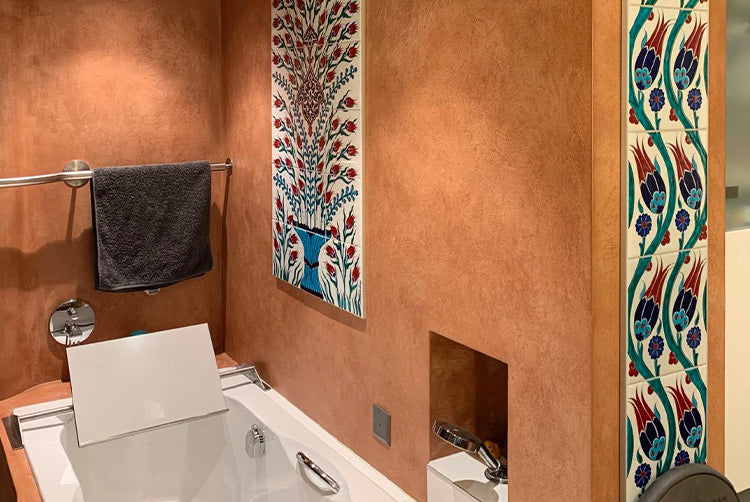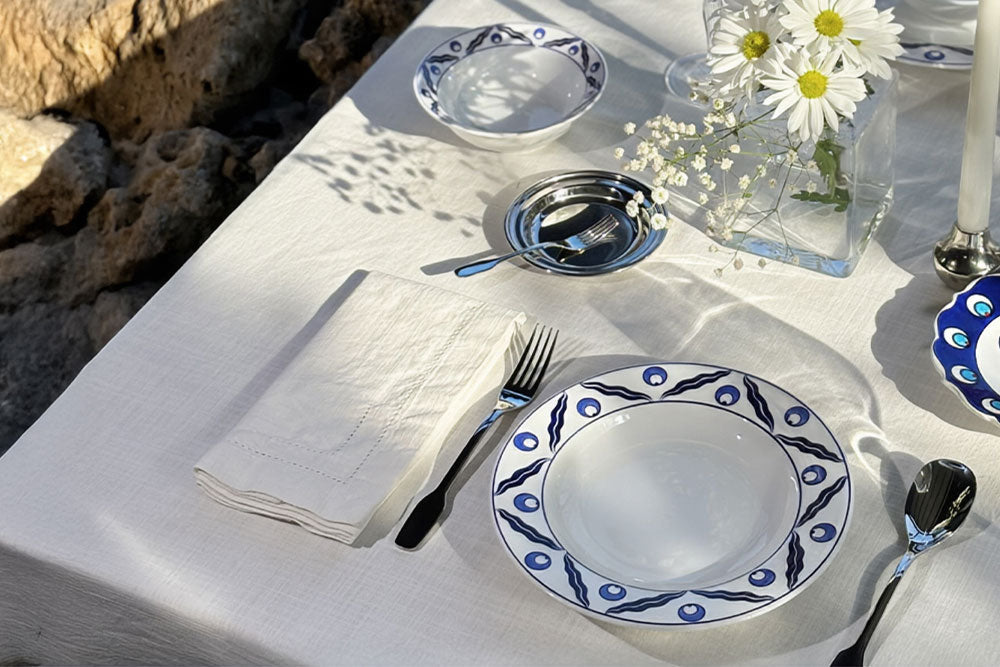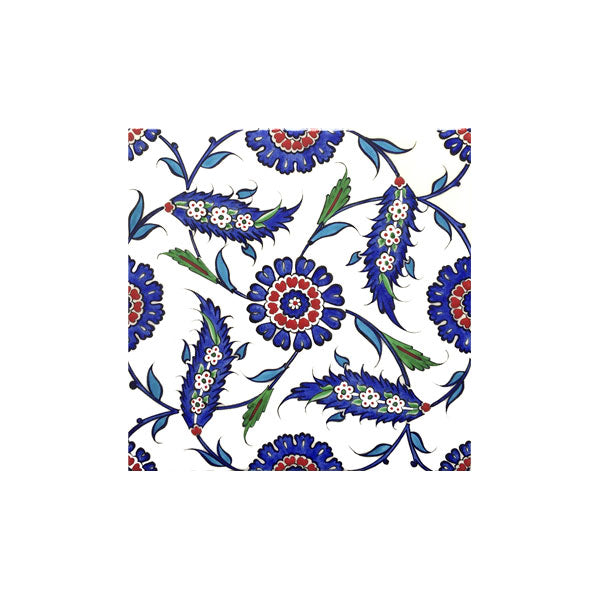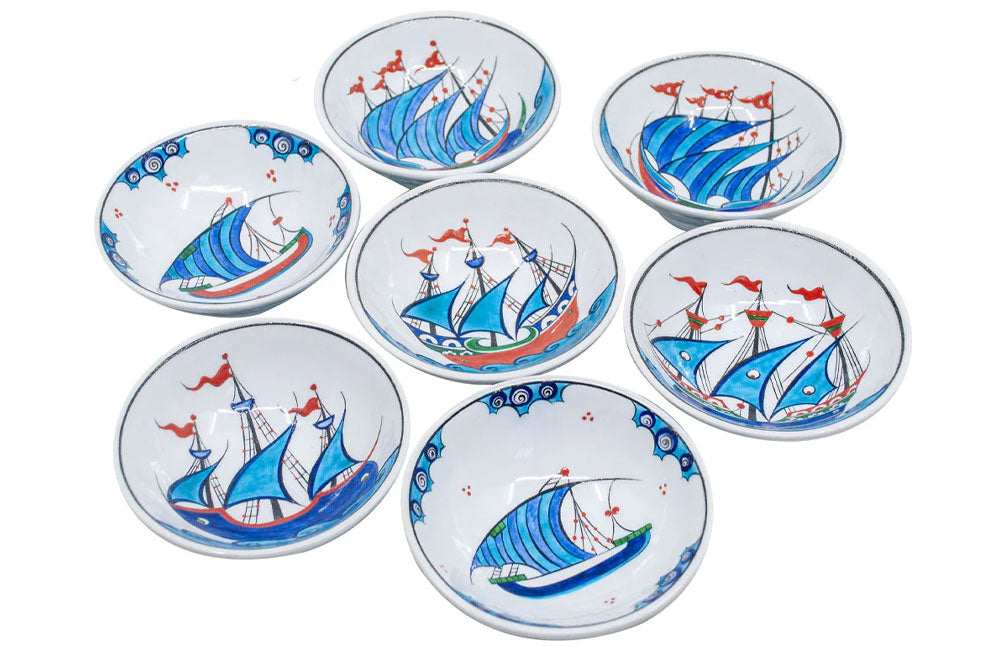Welcome to Iznik tile world
Welcome to Iznik tile world
Art and Culture - Interview with Mehmet Gürsoy about Turkish Tile Art
February 04, 2017 6 min read

He says 'Game of Fire' for iznik tile art. His eyes are shining while he explain this extraordinary iznik tile art. Literally a iznik tile lover. His energy, artist identity and beautiful conversation. We listen with admiration.
- You are very important for Kütahya. Why are Iznik tiles so famous then Kutahya tiles?
Iznik is near the Palace and has quartz mines around it. There is the convenience of transportation. Kütahya is farther away from the palace. For this reason, the tile developed in Iznik.
The patterns drawn by the masters were more easily conveyed to the ottoman palace and for this reason, the Iznik tile reached the summit. The literature says: Iznik is a palace art, Kütahya is a folk art. When the empire is over, the art of Iznik ends, But the folk art continues to live. So Kutahya is very important as well as Iznik.
- You have opened exhibitions in many countries, you have a style and a style of your own, would you tell us about it?
In the year of 1975 when I started tile art, Iznik tiles was burried to history. Very primitive work was being done in Kütahya. The compositions were cut off from the essence, the colors came out of the original, and the pastel colors were produced. But the works I saw in Topkapi Palace in Istanbul, Rüstem Pasha, in the Museum of Turkish Islamic Art in the Chinese Pavilion were spectacular and incredibly beautiful. I said that this is why art is not coming back, it's my way out of art.I was an ordinary teacher, not even high school, I was a village teacher in those years.
This artistic taste was overcome by our teachers. Our ancestors realized the incredible, that the arts have managed the impossible. Iznik tile art has aesthetic, elegance harmony and balance, a composition is beautiful, in short everything is there. First, I had to change the name of this art. When we ask what is tile, we usually get the response of a ceramic type.But for me tile art; Is an eye musical, the notes of this musical are lilies, carnations, hyacinths, roses. Musicians can not make a composition from two notes, but we only make beautiful compositions using blue and white.
In another sense, when I examined China, I saw the original colors of coral, turquoise and emerald. These were jewels, would you look at the horizons of our ancestors? In other words, they hide the precious stones under the glaze, they want to live in the spaces where the jewel colors are found.Why, because these precious stones put positive energy on people and give peace.
I would like to give you an anecdote about Kanuni Sultan Süleyman: The Sultan does not hesitate to accept two artsmen, one is a tailor, the other is an Iznik master. We look at it when we are investigated, and we see that the tailor is his ornament, the tile is ornamental of the palace.The artisans come with excitement to show the work to Sultan. "I've done it for you," artisan says. The Sultan rewards by giving gold to artisans.The artist turns to his workshop in excitement to make more beautiful, peaceful, beautiful works.The art of Turkish tile is the art of 700 years of empire. No country in the world has such an art, Turkish tiles are our own art, the art of the Turks, the great ottoman empire art.The palace artists understood the beauties which created by God so beautifully, so they came to the deep to see the beautiful beauties. First they sent it to the paper, then to the ground, then to the kiln, and finally, these beautiful things came out.
-Let's talk about the colors of China, blue, green, turquoise and red, quite limited.
Sultan Mehmet When he conquered Istanbul, gifts came from all over the world, and porcelain gifts came from Japan and China. These porcelains are just blue and white. The Sultan told his craftsmen: "Make it more beautiful." There is just no blue and white color in nature. In the palace garden, there are lilies, carnations, hyacinths, peonies, crocuses.The palace craftsmen are in search of color. First, they did turquoise, that is our own color, then emerald green, then they carry it the coral red to works. The coral red survived between 1550 and 1575, after which it was no longer produced.Because the master who discover the secret of the red, the formula was buried in the ground with him because of for not telling anyone. Until 1991, this is the case.I had a ten-year research on the coral. I was testing red in every oven. When I opened the exhibition in the Faculty of Fine Arts in 1991, the dean of the faculty *Prof. Nurhan ATASOY says "Son, this job is complete, I am calling for the press". "The coral in history is back," she told the Hurriyet Newspaper. The analyzes show that the uranium mine is in the coral, iron, selenium. And coral red came to the world again.
-Muhsin Demironat - Istanbul Faculty of Fine Arts- is a very important professor. You are the student of Dr.Muhsin Demironat. Did you work with him in your coral work?
I gave his name to this room we interviewed. In 1975, *Vehbi Koç, *Muhsin Demironat, other precious people, said that this Turkish tile art must revive. They took tiles from Kutahya to Vehbi Koç. But those who are taken are not as beautiful as before. The Chinese made these years are very primitive. Vehbi Koç writes an article in the Chamber of Commerce, saying: "Give 10 liras per day to the trainees, this art will develop." In those years I went to Istanbul to develop Turkish art of tile art. At that time I had two choices, either to take a vacation or to go to this course, and I chose the course.
Muhsin Hodja was then in his 60s. I want to tell a story: Faulty flower; stylized of lettuce. I took this drawing to a lesson. 'It is not' said. Again, again, I took my drawing 8-10 times. He said it was not, but I know it happened, I know I'm drawing it. Then I took a blank sheet of paper and said, 'Do you draw for me?' He draws it, I take it when he finished and went to the place. After five or ten minutes, I took it again and said to him, 'This time okay?'. 'It is not' said. I said, 'You drew'. He said, 'Look, son' It was not my drawing, nor your drawing, draw son draw!' 'This art of line art, you know the value of this wrist and your health, you do not have enough time to repeat what the ancestor does, you must try to look at the beautiful reinterpretation' he said. The beautiful approach finds it beautiful, the way of beauty is absolutely beautiful. Like Ferhat, like Kerem, like the others.
-You have opened many exhibitions over the world. How do they welcome you and your works? Do you think we can introduce to the world?
I opened 47 exhibitions over the world, recently in the UK. I did not come back with any of my works, even my works in Indiana sold out in 12 minutes. They know our art better than us, in short, they know us better than we do.
They know their family, studied, read, traveled, saw, embroidered on their brains. The attitude of approaching the works, the attitudes of speaking to you, the glitter in your eyes, the kindness you see. I was honored in many parts of the world. Rectors, governors, mayors, but most importantly, UNESCO has chosen as "Living Human Treasure" of Turkish tile art. I am very proud.
-Nowadays there is a modernization movement, is it possible for you to modernize it?
New applications can be made without deteriorating the characteristics of the flowers. But tulip should stay like the tulip, carnation should stay like carnation, rose should stay like a rose. This is the characteristic of tile art. If we can not change the letters of the alphabet, we can not change the color, character of designs.
-How exactly did this success story begin?
In 1986, the first international tile symposium was organized in Kütahya, where three categories of contests were held. Like everyone else, I got ready, the winners of previous years also participated in the competition. The judge had six foreign and six local jurors. When the results of the competition were announced in three categories, I won two first place and one-second place. I got a great voice in Kütahya. They say where you came from. It had a great impact on the national and international press.
-Do you have the same excitement when you make a dish while you make a cup?
In terms of art value, there is no difference between my greatest and smallest works, but when you make great work, your excitement is bigger.
-What are your recommendations for young people who want to do this art?
Everyone who loves this artificial, my door is open. I have to teach this art for humanity. I have done over five thousand works until today. At the UNESCO award ceremony. They asked, Who will continue this art? My answer is "my son"...
Also in News

Iznik Bathroom Tiles: Combining Traditional Art with Modern Bathroom Design
December 09, 2025 1 min read

Rediscovering Timeless Beauty: Handcrafted Iznik Ceramic Dinnerware for the Modern Table
April 08, 2025 2 min read

Thank you for being here!
Join us to discover the latest in Iznik tiles, enjoy special offers, and celebrate the beauty of Turkish artistry together.

